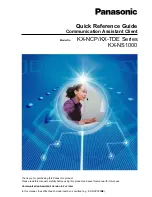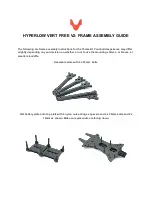
User's
Manual
The following symbols are used in this manual.
This symbol is used in conjunction with the word “WARNING” or “CAUTION.”
Ce symbole est accompagné des termes “AVERTISSEMENT” et “ATTENTION.”
WARNING
Calls attention to actions or conditions that could cause serious or fatal injury to the
user, and precautions that can be taken to prevent such occurrences.
AVERTISSEMENT
Attire l’attention sur des gestes ou des conditions susceptibles de provoquer des
blessures graves (voire mortelles), et sur les précautions de sécurité pouvant
prévenir de tels accidents.
CAUTION
Calls attention to actions or conditions that could cause light injury to the user or
damage to the instrument or the user’s data, and precautions that can be taken to
prevent such occurrences.
ATTENTION
Attire l’attention sur des gestes ou des conditions susceptibles de provoquer des
blessures légères ou d’endommager l’instrument ou les données de l’utilisateur, et
sur les précautions de sécurité susceptibles de prévenir de tels accidents.
Note
Calls attention to information that is important for proper operation of the instrument.
Safety Precautions
This product is designed to be used by a person with specialized knowledge.
Make sure to observe the following safety precautions when handling the current sensor. YOKOGAWA assumes
no liability for the customer’s failure to comply with these safety precautions. Before you use the current sensor,
read the measuring instrument’s manual to fully acquaint yourself with its specifications and handling.
This manual is an essential part of the product; keep it in a safe place for future reference.
The following symbols are used on this instrument.
Handle with care. Refer to the user’s manual or service manual. This symbol appears on dangerous
locations on the instrument which require special instructions for proper handling or use. The same
symbol appears in the corresponding place in the manual to identify those instructions.
Risk of electric shock
Hot surface
Make sure to observe the following safety precautions to prevent electric shock, personal
injury, or damage to the instrument.
WARNING
• Use the Instrument Only for Its Intended Purpose
This instrument is a current output type current sensor. Use the instrument only for
measuring current.
• Beware of electric shock.
• Do not perform measurement if the case is damaged.
• Do not operate the instrument with wet hands, in a rainy or humid environment, or if any
water droplets are visible on it.
• Condensation may appear if sudden changes in temperature occur. If this happens, let
the instrument acclimatize to the new temperatures for at least one hour, then refrain from
using the instrument until confirming that there is no condensation.
• Do not disassemble the instrument.
The instrument should be disassembled by qualified personnel only.
• Use the correct power supply.
Ensure that the source voltage matches the voltage of the power supply before turning the
power ON.
• Do not use uninsulated measurement conductors or cables.
Use conductors or cables with reinforced insulation.
• Make sure that the surface temperature of measurement conductors is within the
instrument's operating temperature range.
• Although it is well-insulated, do not touch the instrument or secondary output cable while
voltage is being applied to the primary conductor.
• Connect the secondary signal output before supplying power to the instrument.
• Do not disconnect the secondary output while power is being supplied to the instrument to
prevent electric shock or damage to the instrument.
• Do not apply primary current before supplying power to the instrument to prevent electric
shock or damage to the instrument.
• Do not input excessive current as malfunction or damage may result.
• Do not allow vibrations to disturb the instrument after it has been set in place as damage may result.
French
AVERTISSEMENT
•
Utiliser l’instrument aux seules fins pour lesquelles il est prévu
Cet instrument est un capteur de courant du type de débit de courant. Utiliser l’instrument
uniquement pour mesurer le courant.
• Faire attention aux chocs électriques.
• Ne pas effectuer une mesure si le boîtier est endommagé.
• Ne pas faire fonctionner le dispositif avec les mains humides, dans un environnement
pluvieux ou humide, ou si des gouttelettes d’eau sont visibles dessus
• La condensation peut s’effectuer et les changements brusques de température se
produisent. Si cela se produit, laisser le dispositif s’acclimater aux nouvelles températures
pendant au moins une heure, puis éviter de l’utiliser jusqu’à confirmer qu’il n’y a pas de
condensation.
• Ne pas démonter le dispositif.
Le dispositif doit être démonté uniquement par un personnel qualifié.
• Vérifier l’alimentation.
S’assurer que la source de tension correspond à la tension de l’alimentation avant la mise
sous tension.
• Ne pas utiliser de conducteurs ou de câbles de mesure non isolés.
Utiliser des conducteurs ou des câbles avec isolation renforcée.
•
S’assurer que la température de surface des conducteurs de mesure se situe dans la plage
de température de fonctionnement du dispositif.
Thank you for purchasing the AC/DC Current Sensor. To ensure correct use, please read this manual
thoroughly before beginning operation.
Please familiarize yourself with the functions and characteristics of the AC/DC current sensor prior to
operation. After reading this manual, keep it in a safe place.
IM CT2000A-01EN
3rd Edition
IM CT2000A-01EN 1/2
•
Bien qu’il soit bien isolé, ne pas toucher le dispositif ou le câble de sortie secondaire pendant
que la tension s’applique au conducteur primaire.
•
Connecter la sortie du signal secondaire avant d’alimenter le dispositif.
•
Ne pas débrancher la sortie secondaire lorsque l’alimentation électrique est fournie au
dispositif afin d’éviter tout risque de choc électrique ou d’endommagement de l’instrument.
•
Ne pas appliquer de courant primaire avant d’alimenter le dispositif afin d’éviter tout risque
d’électrocution ou d’endommager l’instrument.
•
Ne pas entrer de courant excessif, car un dysfonctionnement ou des dommages peuvent en
résulter.
•
Ne pas laisser les vibrations perturber le dispositif après qu’il a été mis en place, car des
dommages peuvent en résulter.
1. Description
This instrument is a current output type current sensor with a 2000:1 current transformation ratio
that performs transformation on the primary current. After familiarizing yourself with the performance
and functions of this instrument, you will be able to use it in conjunction with measuring instruments
from YOKOGAWA.
2. Checking the Contents of the Package
The current sensor consists of the following parts.
CT2000A
Model
Serial Number
MODEL Specifications
CT2000A Current transformation ratio is 2000:1
xxxxxxxxxxxxxxxxxxxxx
xxxxxxxxxxxxxxxxxxxxx
xxxxxx
Standard Accessories
The instrument is shipped with the following accessories. Make sure that all accessories are present
and undamaged.
User’s manual
IM CT2000A-01EN CT2000A
AC/DC Current Sensor
User’s Manual
This manual. This manual explains the
handling precautions, basic usage, and
specifications of the probe.
IM CT2000A-01JA CT2000A
AC/DC Current Sensor
The Japanese version of the above manual
IM CT2000A-92Z1 CT2000A
AC/DC Current Sensor
Document for China
The “EN” and “JA” in the manual numbers are the language code.
Contact information of Yokogawa offices worldwide is provided on the following sheet.
PIM 113-01Z2
Inquiries
List of worldwide contacts
Accessory (Sold Separately)
The optional accessory below is available for purchase separately. Use the accessory specified in
this manual. Moreover, use the accessory of this product only with Yokogawa products that specify
it as accessory.
Output connector
B8200JQ
B8200JQ consists of a connector and attachment screws for
connecting to the CT2000A. A separate cable is required for
making the connection.
Accessory (sold separately) is not covered by warranty of this instrument.
3. Part Names
Front
Top
1
5
6 9
Pin assignment
Figure 1. Names of Parts and Pin Assignments
Primary conductor
feed-through hole
Conductor guide
Secondary connector
Pin No.
1
2
3
4
5
6
7
8
9
Signal
Output Return
[Do not connect]
GND Status
0 V Power Supply Input
–15 V Power Supply Input
Secondary Signal Output
[Do not connect]
Operation Status
+15 V Power Supply Input
Signal allocation of secondary
connector
(four M6)
Attachment screw holes
(four M6)
Attachment screw holes
1
2
3
Pin No.
1
2
3
Signal
Ip Test-
[Do not connect]
Ip Test+
Test winding connector
Test wiring connector
Pin assignment
Direction of current
Operation status LED
4. Operating Procedure
CAUTION
Ensure that the current flowing to the conductor of the object to be measured is within the measuring
range. If the current exceeds the measuring range, the instrument may overheat and get damaged.
French
ATTENTION
S’assurer que le courant qui s’achemine vers le conducteur de l’objet à mesurer se situe
dans la plage de mesure. Si le courant dépasse la plage de mesure, le dispositif peut
surchauffer et subir des dommages.
1.
Connect the secondary connector on the instrument to the current input terminal on the
measuring instrument, and connect to 0 V (common) and ±15 V on the power supply.
2.
Set up the measuring instrument and power supply to match the specifications of the current
transducer. Carefully read the user’s manuals for your measuring instrument and power supply
to perform the correct procedure for making the connections.
Secondary connector
of the current sensor
4
5
9
6
Power supply
0 V(common)
–15 V
+15 V
Current input
terminal
Measuring instrument
Figure 2. Connection Example
1
* Make sure that the total load
resistance including measuring
instrument's internal resistance and
wiring resistance is within the
specification.
3.
Insert the primary conductor into the primary conductor feed-through hole on the instrument.
Make sure that the direction of current flow matches the arrow on the instrument.
CT2000A
AC/DC Current Sensor
3rd Edition: April 2021 (YMI)
All Rights Reserved, Copyright © 2017, Yokogawa Test & Measurement Corporation
Printed in Japan



















